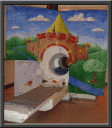Neural Decoders are Making Progress
Saturday, October 31st, 2009 Cognitive designers seek to go beyond usability and look-and-feel to create specific mental states or a “think-and-feel”. Designing for pleasure, emotion, meaning, pain relief and improved decision making, learning and behavioral self-control are only a few of the application areas. The goal is to optimize our designs for how minds work.
Cognitive designers seek to go beyond usability and look-and-feel to create specific mental states or a “think-and-feel”. Designing for pleasure, emotion, meaning, pain relief and improved decision making, learning and behavioral self-control are only a few of the application areas. The goal is to optimize our designs for how minds work.
Taking a systematic approach to cognitive design requires that we can somehow get between the ears of the people we are designing for and understand inner mental life and how it is shaped by features, functions and forms.
So I am always on the look out for new tools and techniques for modeling mental states and processes. The holy grail is neural decoding or the ability to translate measurable data on brain activity into the meaning of thoughts, emotions and actions. In short, directly reading the mind. The state of the art in neural decoding was discussed at a recent Society for Neuroscience meeting in Chicago. The New Scientist offers an excellence synopsis in Brain Scanner Can Tell What You are Thinking About.
Nothing yet for the designer’s toolkit but some very interesting developments:
“He (Jack Gallant) and colleague Shinji Nishimoto showed that they could create a crude reproduction of a movie clip that someone was watching just by viewing their brain activity. Others at the same meeting claimed that such neural decoding could be used to read memories and future plans – and even to diagnose eating disorders.”
Being able to accurately and cost effectively translate biometric information from our nervous systems into the corresponding thoughts, feeling, motivations and intentions will be one of the major innovations of the 21st century. Among other things, it will provide the foundation needed to take an exacting approach to optimizing our designs for how minds really work. Cognitive design unleashed.










